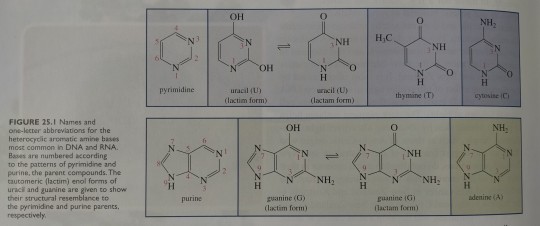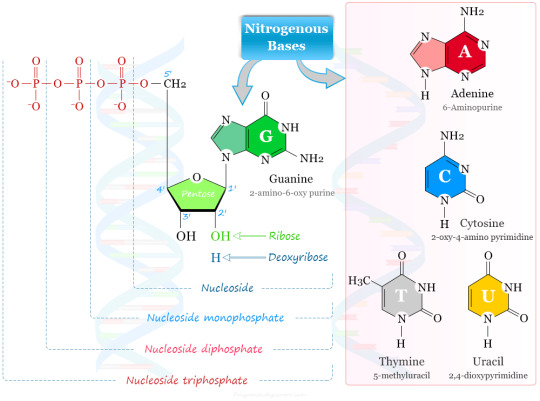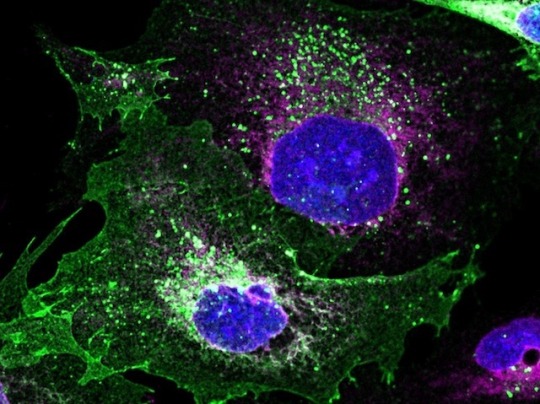#nucleic acid
Text
Figure 25.1 shows the five heterocyclic aromatic amine bases most common in nucleic acids.

"Chemistry" 2e - Blackman, A., Bottle, S., Schmid, S., Mocerino, M., Wille, U.
#book quotes#chemistry#nonfiction#textbook#heterocyclic#aromatic#amines#base#nucleic acid#pyrimidine#uracil#thymine#cytosine#purine#guanine#adenine#tautomer#lactim#lactam
1 note
·
View note
Text

Introducing G2M’s newly launched EZY-AutoPrep—an automated #NGS library preparation workstation capable of constructing 24 sample libraries in a single run. With user-friendly software and supporting hardware, EZY-#AutoPrep ensures quick sample processing, delivering a seamless library preparation experience. Features include heating, cooling, #magnetic plate lifting, #PCR cycling, UV sterilization, and efficient purification which ensures precise, contamination-free library construction.
#Revolutionize your #NGS workflow with EZY-AutoPrep.
Visit our website for more information: https://genes2me.com/automated-ngs-library-sample-preparation
For more details, Call us at +91-8800821778 or drop us an email at [email protected]
#rtpcr #genes2me #nextgenerationsequencing #nextgeneration #sequencing #automated #ivd #dna #rna #protocols #nucleicacid
#rt-pcr#pcr#g2m#genes2me#ivd#ngs#revolutionize#AutoPrep#magnetic#dna solutions#rna solutions#automated#nucleic acid#nucleic acid extraction
0 notes
Text
They facilitate intercellular communication during plant development, enabling cytoplasmic exchange of vital developmental signals in the form of proteins, nucleic acids, and other macromolecules.
"Plant Physiology and Development" int'l 6e - Taiz, L., Zeiger, E., Møller, I.M., Murphy, A.
#book quote#plant physiology and development#nonfiction#textbook#plasmodesmata#cytoplasm#communication#protein#nucleic acid#macromolecule#cells#plants
0 notes
Text
為什麼非要逼我做核酸
我在睡覺突然給我套上衣服讓我去寒風里排隊
我:你為什麼這麼配合做核酸?
:因為這是我的義務。
我:你為什麼打疫苗?
:因為這是我的義務。
我:你打疫苗不是為了防治感染嗎?
:不是,是為了減輕症狀。
我:所以重症的人都沒打疫苗嗎?
:不一定。
我:那打這個疫苗的目的是什麼?
:…
我:你支持一天兩檢嗎?
:不支持。
我:為什麼?
:沒意義啊。
我:那一天一檢就有意義了嗎?
:…
我:那一天一檢就有意義了嗎?
:我不知道。
我:你覺得市長也經常做核酸嗎?
:人家肯定有專門的團隊啊。
我:那是不是我從政了也可以為所欲為?
:那是不對的。
我:那市長為什麼沒覺得不對?
:…
:你看這麼多排隊的人老老小小都在做核酸,你四肢健全連這兩步遠也懶得走嗎?
我:有沒有可能不想做核酸的人根本不會出現在做核酸的隊列裡,除了哄你開心的我。
……
總之今天一上午都是這樣的
回答一切他知道有疑點的問題
他都用“我不知道”來迴避
並不是說我覺得“眾人皆醉我獨醒”
又羨慕他們又可憐他們
1 note
·
View note
Text
Tinykawa’s day out
#Pregnancy#friendship#dinosaur#scared of teacher#avril lavine concert#criteria#nucleic acid#avoid virus by avoiding virus#The hammer is satisfied
1 note
·
View note
Link
#Eleven Therapeutics#therapeutics#therapy#biotech#biotechnology#ai#artificial intelligence#israel#uk#medtech#health tech#nucleic acid
0 notes
Text
had my version of drunk history tonight when someone w no science background wanted a detailed description of my research whilst i was several drinks in
#he was surprised bacteria have complex things like proteins so i was trying to explain that there are 4 biomolecules everyones got#(carbohydrates lipids nucleic acids proteins)#and it says something about my level of sobriety that i was struggling to list the four for him#this should be my test of handling alcohol in future. how many drinks until you forget the central dogma of molec bio or something
8 notes
·
View notes
Text
I’m actually really fucking stoked to go back to work unfortunately
#that post that’s like if capitalism wasn’t a thing what job would you do#and op was like btw if you say engineer or something ill kill you#makes me so sad. Because#If capitalism wasn’t a thing I’d still be a nucleic acids molecular biologist#I think life sciences is the coolest thing on earth like I literally get to work on figuring out how life itself functions#like. brother the universe is understanding itself. Do you get it. The universe invented sentient life and now that sentient life is seeking#to understand what makes it work
9 notes
·
View notes
Text

What is Nucleotide?
A nucleotide that contains a nitrogenous base, a pentose sugar, and a phosphate group in its structure. It is the basic building block of nucleic acids − deoxyribonucleic acid (DNA) and ribonucleic acid (RNA) for more about nucleotide
3 notes
·
View notes
Text
CNA frustrates me, because it's clearly analogous to DNA but obviously there's gotta be differences because well DNA is organic, but I'm super confused to how CNA would work because molecules are super super super specific. Aaand I'm p sure it's been displayed as a specific double helix, so that just creates MORE issues because how many chemicals can create double helixes?
All i can really jam in my head is perhaps a silicon based structure and ssssome inspiration from corals with the metal? Because technically coral as the animals are the little anemone looking squishy guys who live in the calcium of the coral. I've had this wacky dacky theory in my head that the sparks are technically the actual well organism of a Cybertronian, while the outer frame is a hyper specialized shell. "But why can they feel pain if it's a shell-" shelled animals do feel pain through their shells, because otherwise they wouldn't be able to tell what's wrong. One would say this would take forever to evolve, but considering how transformers are created I'd argue there's enough variation from individual to individual (aaand maybe a bit of data getting sent back to what makes then?) that evolution could be fast tracked. Of course, you could say it's directly based on organic life, but then you'd have to think about what organic life was alive before and during the emergence of the first Cybertronians.
No matter how something is created, trial and error is at the heart of anything's evolution. Make something, see how it worked, and go with what worked. Little mistakes happen, and well the mistakes that are harmless or beneficial happen are selected for.
#tf worldbuilding?#cybertronian biology#if we're going to look at canon I'd suggest comparing Cybertronian evolution to computer generation#especially since in canon they are created using asexual reproduction so it's more like an evolution game#CNA is mostly mentioned in tfp and iicr stands for cybernetic nucleic acid#and I'm sorry but I'm really bad at suspending my disbelief especially when we can invent fun bullshit answers#... also i can get ~funky~ and invent new elements just for transformers lol
18 notes
·
View notes
Text
However, plant cells, unlike animal cells, are further enclosed by a rigid, cellulosic cell wall (Figure 1.4). (...) Plant cells have two types of walls: primary and secondary (see Figure 1.4A).

The cytoplasm of neighboring cells is usually connected by means of plasmodesmata (singular plasmodesma), tubular channels 40 to 50 nm in diameter and formed by the connected plasma membranes of adjacent cells (see Figure 1.4A-D). (...) Secondary plasmodesmata form after cell division is completed, across primary or secondary cell walls (see Figure 1.4A), when small regions of the cell walls are digested by enzymes and plasma membranes of adjacent cells fuse to form the channel. The endoplasmic reticulum network of adjacent cells is also connected, forming the desmotubule (see Figure 1.4C and D) that runs through the center of the channel. Proteins line the outer surface of the desmotubule and the inner surface of the plasma membrane (see Figure 1.4D); the two surfaces are thought to be connected by filamentous proteins (spokes), which divide the cytoplasmic sleeve into microchannels. (...) The transport can be followed by studying the movement of fluorescently labeled proteins or dyes between cells (see Figure 1.4E-G). (...) Thus, single channels, referred to as simple plasmodesmata, can form branched plasmodesmata (see Figure 1.4A) when they connect with each other. (...) As a result, even virus-sized particles can readily move through the plasmodesmata to a neighboring cell (see Figure 1.4F and G). (...) The cell plate-spanning ER tubules establish the sites for the primary plasmodesmata (see Figure 1.4B-D). (...) Once made, guard cells remain cytoplasmically isolated from the rest of the leaf because during the last division that forms them, no plasmodesmata are made in the forming cell plate (note the absence of the green spots that indicate plasmodesmata in the guard cells in Figure 1.4E). (...) The prominent nuclear structure called the nucleolus (see Figure 1.4) consists of the rDNA of the NOR, the proteins that transcribe the rDNA and process the rRNA primary transcripts for assembly into ribosomes, and the immature ribosomes just being assembled. (...) The walls on the different sides of a cell may vary in thickness, in amount and type of impregnating substances, in sculpting, and in frequency of pitting and plasmodesmata – tiny membrane-lined channels that allow passive transport of small molecules and active transport of proteins and nucleic acids between the cytoplasm of adjacent cells (see Figure 1.4).
"Plant Physiology and Development" int'l 6e - Taiz, L., Zeiger, E., Møller, I.M., Murphy, A.
#book quotes#plant physiology and development#nonfiction#textbook#cells#plants#plasmodesmata#cell wall#rdna#rrna#transcription#proteins#transportation#active transport#passive transport#impregnating#nucleic acid#plant cells
0 notes
Text

#G2M is thrilled to introduce you to our highly efficent #FFPE DNA Extraction kit which is designed for the purification of genomic #DNA from formalin-fixed paraffin-embedded (FFPE) tissue sections. Fixing of #tissues using formalin generates the cross-linking of the #NucleicAcids, proteins. This kit enables the partial reversing of the modification caused by formalin which results in high yield with good #quality.
Visit our website for more information https://www.genes2me.com/ffpe-dna-extraction-kit
For more details, Call us at +91-8800821778 or drop us an email at [email protected]
#extraction #Genes2me #kits #purification #solutions #genomics #technology #rtpcr #rna #madeinindia #india #manufacturer
#g2m#genes2me#ffpe#formalin fixed paraffin embedded#nucleic acid#quality#dna#extraction#purification#rna#tissues#rt pcr#kits
0 notes
Quote
It cannot be said too often: all life is one. That is, and I suspect will forever prove to be, the most profound true statement there is.
from A Short History of Nearly Everything by Bill Bryson
#a short history of nearly everything#bill bryson#life itself#life on earth#the stuff of life#dna#rna#genetics#molecular genetics#biology#proteins#nucleic acids#stuff of life#genetic info#genetic information#all life is one#profound#true#truth#science#genetic code
14 notes
·
View notes
Text
The Four Vital Macromolecules of Biology: Structure, Differences, and Functions
Biology is an intricate tapestry of interactions and functions, with the fundamental building blocks being macromolecules. These large molecules play significant roles in almost all biological functions and processes. They are crucial for the structure, function, and regulation of the body’s tissues and organs. Let’s delve into the four primary macromolecules, exploring their differences and…

View On WordPress
2 notes
·
View notes
Text

did not understand a single thing during class, learned half the syllabus last night
now as thor would say, BRING ME THE TEST
#if anyone sees this please send a prayer for me#learned the whole replication cycle for like a FUCK ton of viruses#down to the nucleic acid#help#molecular virology#genomics#biotech#science meme#iron man#avengers
16 notes
·
View notes
Photo

Repair Kit Delivery
If you have problems at a factory, it’s better to fix the machinery than repair each item produced. This is the philosophy of gene therapy, which aims to solve errors in DNA and subsequent protein production rather than manage the eventual symptoms. Steroid-resistant nephrotic syndrome is a debilitating genetic condition in which the protein podocin, which usually sits on the surface of kidney cells, becomes stuck inside. Many gene therapies use viruses to transport material into cells, but many of these are of limited size, so are like trying to manoeuvre a crane in place with a bicycle. A new study modified the harmless baculovirus to have large capacity, and used it to smuggle replacement DNA sequences, molecular scissors, and guiding nucleic acids into diseased cells (pictured). Podocin (green) was restored to the cell surface, addressing the problem at its source and proving the technique’s potential for many applications.
Written by Anthony Lewis
Image from work by Francesco Aulicino and colleagues
BrisSynBio Bristol Synthetic Biology Centre, Biomedical Sciences, School of Biochemistry, University of Bristol, Bristol, UK
Image originally published with a Creative Commons Attribution 4.0 International (CC BY 4.0)
Published in Nucleic Acids Research, July 2022
You can also follow BPoD on Instagram, Twitter and Facebook
#science#biomedicine#podocin#nephrotic syndrome#kidneys#crispr#gene editing#molecular scissors#baculovirus#nucleic acids#gene therapy#immunofluorescence
9 notes
·
View notes